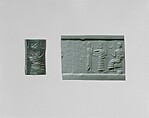Cylinder seal: seated figure approached by a goddess leading a worshiper
Not on view
Although engraved stones had been used as early as the seventh millennium B.C. to stamp impressions in clay, the invention in the fourth millennium B.C. of carved cylinders that could be rolled over clay allowed the development of more complex seal designs. These cylinder seals, first used in Mesopotamia, served as a mark of ownership or identification. Seals were either impressed on lumps of clay that were used to close jars, doors, and baskets, or they were rolled onto clay tablets that recorded information about commercial or legal transactions. The seals were often made of precious stones. Protective properties may have been ascribed to both the material itself and the carved designs. Seals are important to the study of ancient Near Eastern art because many examples survive from every period and can, therefore, help to define chronological phases. Often preserving imagery no longer extant in any other medium, they serve as a visual chronicle of style and iconography.
The modern impression of the seal is shown so that the entire design can be seen. This seal shows a so-called presentation scene, the most common motif on cylinder seals of the Ur III period. A bald, clean-shaven worshiper, wearing a long, fringed robe and holding the palm of his right hand before his mouth, presumably is the seal's owner, Ilum-bani, identifiable from the framed, eight-line inscription: "Ibbi-Sin the strong king, king of Ur, King of the four quarters [of the world] // Ilum-bani the overseer, son of Ili-ukin [is] your servant." He is led by a goddess wearing a flounced robe that drapes over her left shoulder and a cap with four pairs of horns. She grasps his left wrist in her right hand, raises her left hand in a salute, and presents the worshiper to the seated figure of a deified king, apparently a young Ibbi-Sin, who, in the inscription, is identified with the divine determinative. He, too, wears a flounced garment draped over his left shoulder and a brimmed cap. Seated on a padded stool set on a low platform, he holds forth a cup perched on his pursed fingertips. A star disk within a crescent moon occupies the upper field in front of the king. These seals, highly standardized in both their iconography and their inscription formulas, were apparently restricted to a class of high public officials ranking just below the king in the administrative hierarchy.
This image cannot be enlarged, viewed at full screen, or downloaded.

